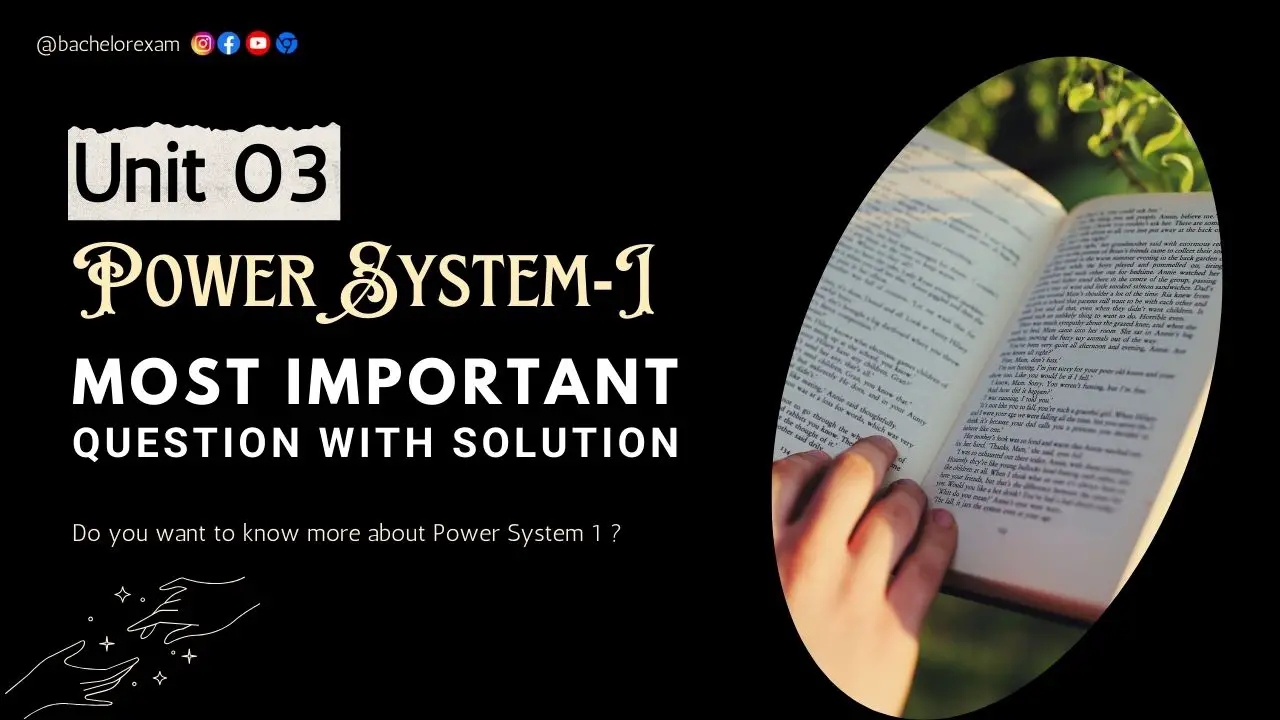Aktu Btech Quantum Notes can help you understand Power System-I better. These important, commonly asked questions can help you prepare for the exam. Now is the time to boost your performance! Unit-3 Transmission and Distribution of Electric Power-l
Dudes 🤔.. You want more useful details regarding this subject. Please keep in mind this as well. Important Questions For Power System-I: *Quantum *B.tech-Syllabus *Circulars *B.tech AKTU RESULT * Btech 3rd Year * Aktu Solved Question Paper
Q1. Explain sag template and its use.
Ans.
- 1. A useful tool for determining the position and height of towers during transmission line design is the sag template.
- 2. The sag and the type of the conductor curve are estimated under the projected load conditions and displayed on a thin strong plastic sheet. This graph is known as the sag template and is used to locate the tower placements for normal spans and standard towers.
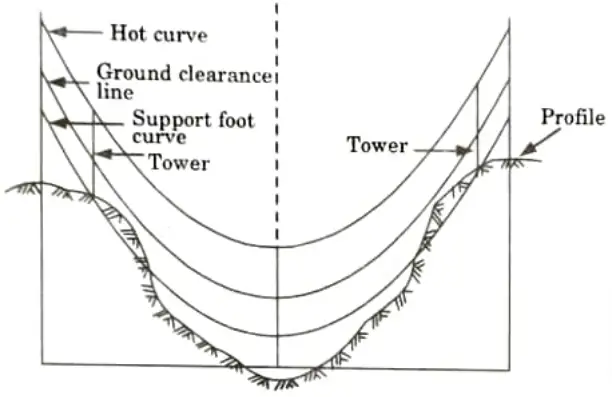


- 3. The curves which are marked on it are:
- i. Location of support (tower) or Hot curve: Plotting sags at maximum temperature against span lengths yields these curves. It tells us where to put supports so that we may keep the right amount of ground clearance.
- ii. Ground clearance curve: Underneath hot curve is this curve. It is drawn at a vertical distance equivalent to ground clearance as required by the regulations for the provided line, parallel to the hot curve.
- iii. Support foot curve or tower curve: It is drawn to show where the tower lines will be supported. It displays the height between the lowest conductor’s connection point and the bottom of the standard support.
- iv. Uplift curve or cold curve: The sags at the lowest temperature without ice or wind loads are plotted against the span length to obtain this. They are created to determine if conductors ever lift off of a support.
- 4. Use of sag template:
- i. For correct design and economy.
- ii. It is used to allocate the position and height of the support correctly on the profile.
Q2. Describe pin type, suspension type and strain type insulators with net sketch.
Ans. A. Pin type insulator:
- 1. Pin type insulators are used for transmission and distribution of electric power at voltage upto 33 kV.
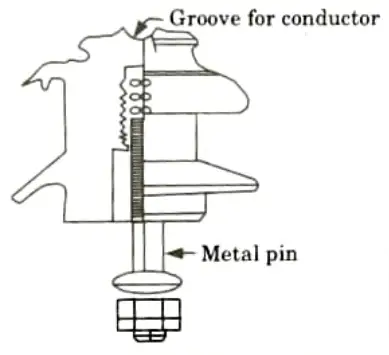


- 2. The pin type insulator becomes bulky and therefore uneconomical above an operating voltage of 33 kV.
- 3. The conductor is housed in a groove on the upper end. Steel bolts are used to firmly fasten the pin insulators to the transmission pole’s cross arm.
- 4. The binding wire, which is made of soft copper or soft aluminium, or the same material as the conductor, passes through the groove on the upper end of the conductor and secures it.
Advantage: It is cheaper for upto operating voltage of 33 kV.
Disadvantage: At increased operating voltage, this sort of insulator becomes incredibly bulky, and its price also rises quickly.
B. Suspension insulator:
- 1. High transmission lines employ these insulators. There are many porcelain disc units in these insulators. Metal links are used to connect these units in a series to one another.
- 2. This creates a line of ceramic discs. The lowest insulator is used to hold the conductor along the conductor shoe, while the highest insulator is attached to the cross arm of the tower.
- 3. Although each unit is made to withstand low voltage, such as 11 kV, a series of such units provides us with the necessary protection against high level voltage.
- 4. The overall string of suspension type insulator is shown in the Fig.
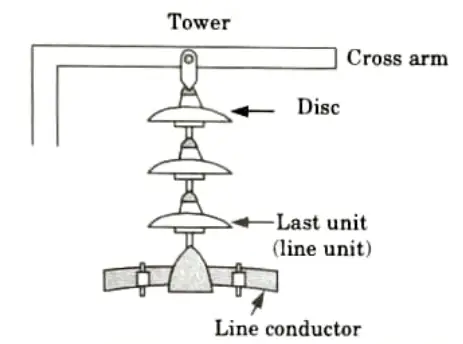


Advantages:
- 1. If any of the units fail, replacement work can be completed quickly, negating the need to replace the entire string.
- 2. This type of insulator provides greater flexibility to the line.
Disadvantage: Large distances between the string conductors are necessary for suspension type insulators.
C. Strain insulators:
- 1. These insulators are employed when a line comes to a dead end, makes a sudden turn, crosses a river, etc.
- 2. In such exceptional circumstances, these insulators lessen the excessive tension on the line. Insulators are utilised for high voltage strain.
- 3. The strain insulators’ discs are arranged in a vertical plane.
- 4. The line is under extreme tension in situations like river crossings. In this scenario, two or more insulator strings are employed in tandem.
Advantage: It is economical for high operating voltage.



D. Shackle insulator:
- 1. Spool insulators are another name for these. Low voltage distribution lines primarily employ them.
- 2. These insulators can be utilized either vertically or horizontally. They are employed where there is an excessive amount of mechanical stress on the line, such as at the dead end of the aerial wire of the service connection to a home or a factory.
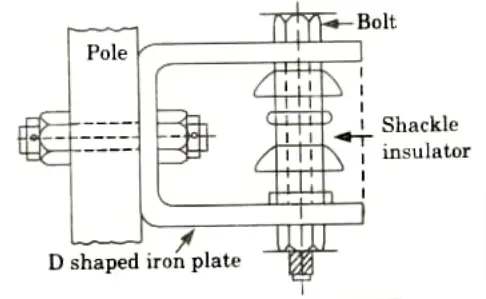


E. Stay insulators:
- 1. Egg insulators are another name for remain insulators. Low voltage lines require that the stays be insulated at a height of at least three metres above the ground.
- 2. To produce insulation between the pole and the stay clamp, the stay wire is fitted with stay insulators.
- 3. Porcelain is typically used to make it. It contains two holes for the stay wires, and the design ensures that they won’t fall to the ground if the insulator breaks.



Q3. Explain why the voltage does not divide equally across the units of a string insulator. Find the voltage distribution and string efficiency of a three unit suspension insulator string if the capacitance of the link pins to earth and to the line are respectively 20 % and 10 % of the self capacitance of each unit. If a guard ring increases the capacitance to the line of lower link pin to 35 % of the self capacitance of each unit, find the redistribution of voltage and string efficiency.
Ans. A. Reason: A string insulator’s many units do not distribute voltage uniformly. The main cause of this is the capacitance between the metal components of the insulators and the tower structure.
B. Numerical:
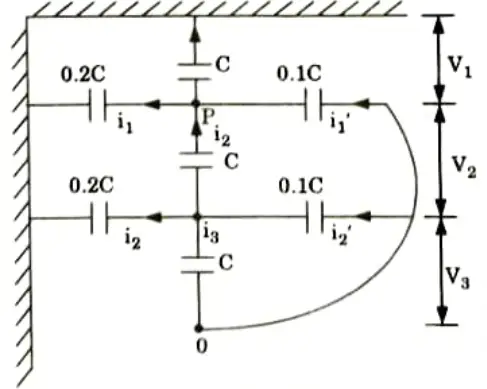


1. Applying KCL at node P,



2 Similarly at Q,



With guard ring: Pin to line capacitance is increased from 0.1C to 0.35C.
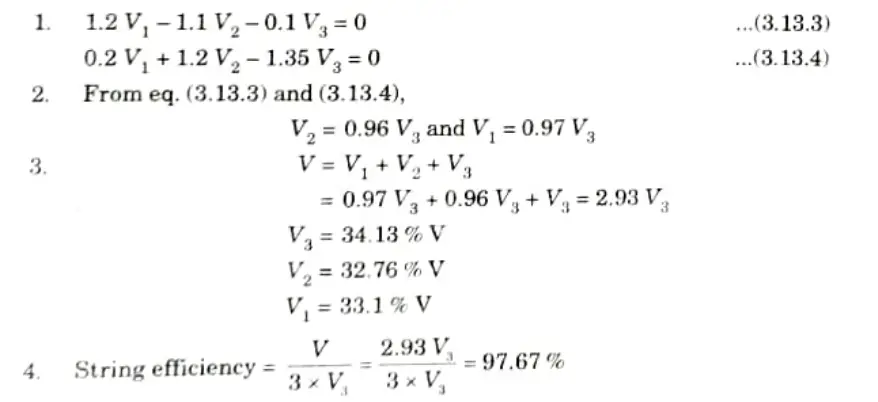


Q4. A string of n suspension insulators is to be fitted with a guard ring. If the pin to earth capacitance are all equal to C, derive the general expression for the line to pin capacitor in terms of n, C and p (number of pins), so as to give uniform voltage distributions over the string.
Ans. 1 Since voltage across each unit is same, current flowing in each unit, i.e. I1,I2……..I6,I7 etc will be equal.
2. Applying KCL at junction P,
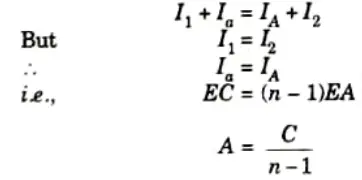


3. Similarly, by applying KCL at Q,
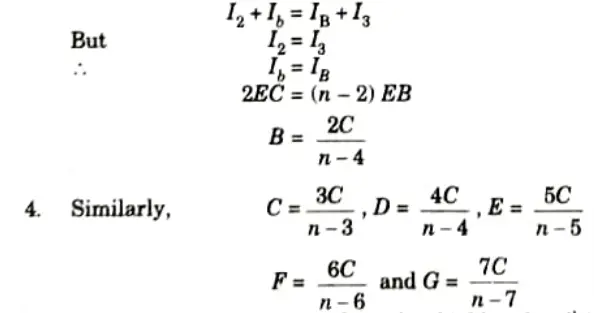


5. In general the capacitance from the shield to the pth link from the top is






Q5. A transmission line has a span of 150 m between level supports. The line conductor has a cross sectional area of 1.25 cm2 and it weights 120 kg per 100 m. If the breaking stress of the copper conductor is 4220 kg/cm2, calulate the maximum sag for a safety factor of 4. Assume maximum wind pressure of 90 kg/m2 of projected surface.
Ans. Given: L = 150 m, a = 1.25 cm2, k = 4, Weight = 120 kg/100 m
= 1.2 kg/m, Breaking stress= 4220 kg/cm2
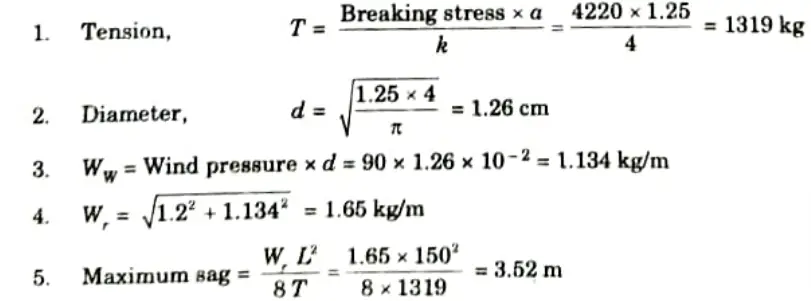


Q6. Explain how the potential is distributed over a string of suspension insulators ? Also write about string efficiency.
Ans. A. Voltage distributed over a string:



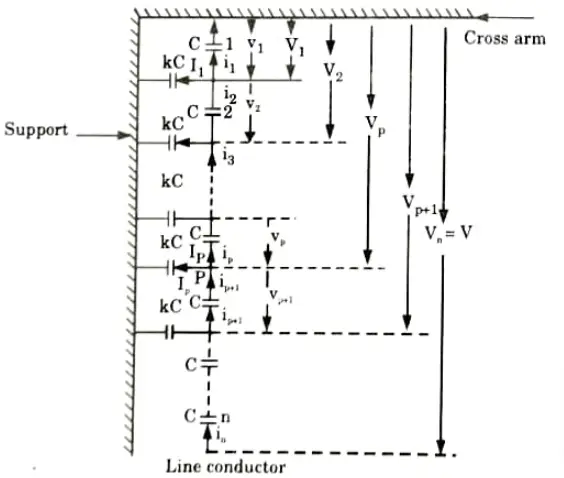


2. Applying KCL at node P,






We can find voltage across any string using eq. (3.11.) and (3.11.2).
3. Let us find voltage across each insulator of each string i.e., to calculate



4. Top most insulator or first insulator:
Voltage across insulator = v1
5. Second insulator :



6. Third insulator:



7. Fourth insulator:



Similarly, we can calculate for all insulators.
8. It is clear that



The voltage drop across the top unit will be the smallest because the mutual capacity of each disc is the same and the current through it is the least. The current continues to rise as it approaches the power conductor, peaking in the lowest unit. The voltage drop is therefore greatest there.
B. String Efficiency: String efficiency is measure of the utilization of material in the string and is defined as :






Important Question with solutions | AKTU Quantums | Syllabus | Short Questions
Power System-I Btech Quantum PDF, Syllabus, Important Questions
| Label | Link |
|---|---|
| Subject Syllabus | Syllabus |
| Short Questions | Short-question |
| Question paper – 2021-22 | 2021-22 |
Power System-I Quantum PDF | AKTU Quantum PDF:
| Quantum Series | Links |
| Quantum -2022-23 | 2022-23 |
AKTU Important Links | Btech Syllabus
| Link Name | Links |
|---|---|
| Btech AKTU Circulars | Links |
| Btech AKTU Syllabus | Links |
| Btech AKTU Student Dashboard | Student Dashboard |
| AKTU RESULT (One VIew) | Student Result |
